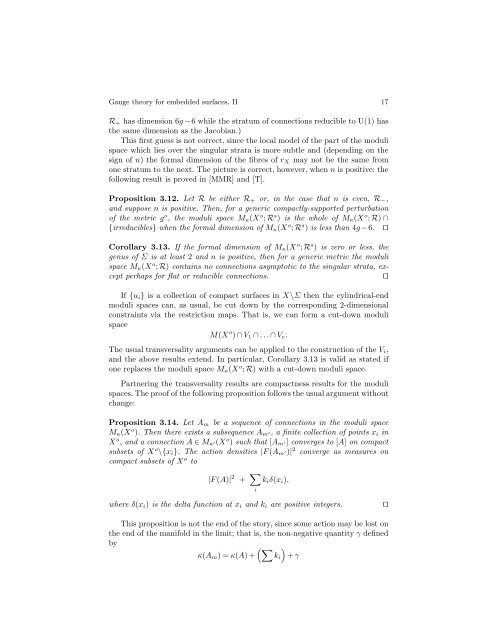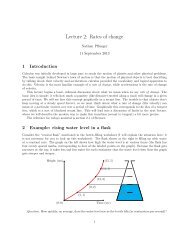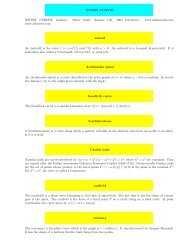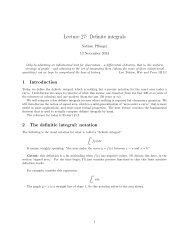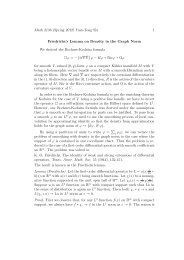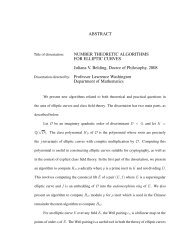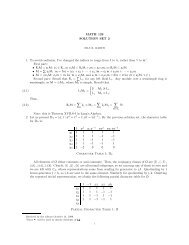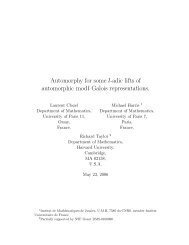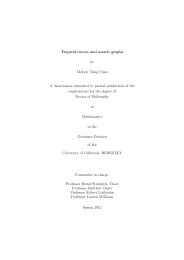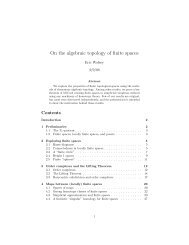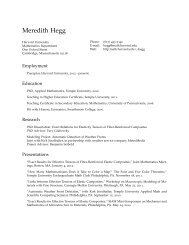Gauge theory for embedded surfaces, II
Gauge theory for embedded surfaces, II
Gauge theory for embedded surfaces, II
You also want an ePaper? Increase the reach of your titles
YUMPU automatically turns print PDFs into web optimized ePapers that Google loves.
<strong>Gauge</strong> <strong>theory</strong> <strong>for</strong> <strong>embedded</strong> <strong>surfaces</strong>, <strong>II</strong> 17<br />
R+ has dimension 6g −6 while the stratum of connections reducible to U(1) has<br />
the same dimension as the Jacobian.)<br />
This first guess is not correct, since the local model of the part of the moduli<br />
space which lies over the singular strata is more subtle and (depending on the<br />
sign of n) the <strong>for</strong>mal dimension of the fibres of rX may not be the same from<br />
one stratum to the next. The picture is correct, however, when n is positive: the<br />
following result is proved in [MMR] and [T].<br />
Proposition 3.12. Let R be either R+ or, in the case that n is even, R−,<br />
and suppose n is positive. Then, <strong>for</strong> a generic compactly-supported perturbation<br />
of the metric g o , the moduli space Mκ(X o ; R s ) is the whole of Mκ(X o ; R) ∩<br />
{irreducibles} when the <strong>for</strong>mal dimension of Mκ(X o ; R s ) is less than 4g −6. ⊓⊔<br />
Corollary 3.13. If the <strong>for</strong>mal dimension of Mκ(X o ; R s ) is zero or less, the<br />
genus of Σ is at least 2 and n is positive, then <strong>for</strong> a generic metric the moduli<br />
space Mκ(X o ; R) contains no connections asymptotic to the singular strata, except<br />
perhaps <strong>for</strong> flat or reducible connections. ⊓⊔<br />
If {ui} is a collection of compact <strong>surfaces</strong> in X\Σ then the cylindrical-end<br />
moduli spaces can, as usual, be cut down by the corresponding 2-dimensional<br />
constraints via the restriction maps. That is, we can <strong>for</strong>m a cut-down moduli<br />
space<br />
M(X o ) ∩ V1 ∩ ...∩Ve.<br />
The usual transversality arguments can be applied to the construction of the Vi,<br />
and the above results extend. In particular, Corollary 3.13 is valid as stated if<br />
one replaces the moduli space Mκ(X o ; R) with a cut-down moduli space.<br />
Partnering the transversality results are compactness results <strong>for</strong> the moduli<br />
spaces. The proof of the following proposition follows the usual argument without<br />
change:<br />
Proposition 3.14. Let Am be a sequence of connections in the moduli space<br />
Mκ(X o ). Then there exists a subsequence Am ′, a finite collection of points xi in<br />
X o ,andaconnectionA∈Mκ ′(Xo )such that [Am ′] converges to [A] on compact<br />
subsets of X o \{xi}. The action densities |F (Am ′)|2 converge as measures on<br />
compact subsets of Xo to<br />
|F (A)| 2 + <br />
kiδ(xi),<br />
where δ(xi) is the delta function at xi and ki are positive integers. ⊓⊔<br />
This proposition is not the end of the story, since some action may be lost on<br />
the end of the manifold in the limit; that is, the non-negative quantity γ defined<br />
by<br />
<br />
κ(Am)=κ(A)+ ki +γ<br />
i


